An Evaluation and Optimization of Green Development Strategy for the Nanjing-Hangzhou Eco-Economic Zone in China
Abstract
1. Introduction
2. Data and Methods
2.1. Overview of the Research Background and Data Sources
2.1.1. Overview of the Research Background
2.1.2. Data Sources
2.2. Evaluation System Construction
2.2.1. Construction of Green Development Indicator System
2.2.2. Brief Introduction of the Green Development Evaluation Method
3. Results and Evaluation
3.1. Comprehensive Evaluation of the Green Development of the Nanjing-Hangzhou Eco-Economic Zone
3.2. Time Series Dynamic Evolution of the Characteristics of Five Subsystems of Green Development in the Nanjing-Hangzhou Eco-Economic Zone
3.3. Spatial Mapping of Current Green Development Problems in the Nanjing-Hangzhou Eco-Economic Zone
3.3.1. Lagging Driving Innovation: “Strong Stem and Weak Branch” of Urban Structure
3.3.2. Low Economic Performance: Industrial Structure Is “Heavy on Nanjing and Light on Hangzhou”
3.3.3. Weakening of Social Welfare: Urbanization Development Is “Attaching Importance to Quantity and Ignoring Quality”
4. Green Development-Oriented Spatial Optimization Strategy of the Nanjing-Hangzhou Ecological Economic Zone
4.1. Optimize the Pattern of Regional Division of Labor and Strengthen the Radiating and Driving Role of Central Cities
4.1.1. Improve the Functions of the Central City
4.1.2. Optimize Regional Division of Labor
4.2. Cultivate and Strengthen New Drivers of Growth, and Promote Industrial Orientation of Regional Green Economy
4.2.1. Build a Hierarchical Green Economic System
4.2.2. Vigorously Develop Scientific and Technological Innovation Industries
4.2.3. Optimize the Distribution of Cultural and Creative Industries
4.2.4. Compact the Comprehensive Development of Characteristic Agricultural and Forestry Products
4.3. Explore New Urbanization Models and Build a New Pattern of Green Development
4.3.1. Spatial Pattern of Population Aggregation Guided by New Ecological Economy
4.3.2. Co-Construction and Sharing of Regional Infrastructure to Promote Urbanization
4.3.3. On-Site Urbanization Model of Population Driven by Agricultural Modernization
4.3.4. New Pattern of Urban and Village Space Guided by the Rural Vitalization Strategy
5. Conclusions and Discussion
Author Contributions
Funding
Conflicts of Interest
References
- Cui, X.G.; Fang, C.L.; Liu, H.M.; Liu, X.F. Assessing sustainability of urbanization by a coordinated development index for an Urbanization-Resources-Environment complex system: A case study of Jing-Jin-Ji region, China. Ecol. Indic. 2019, 96, 383–391. [Google Scholar] [CrossRef]
- Jiang, Y.F.; Long, H.L.; Tiang, Y.T.; Deng, W.; Chen, K.Q.; Zheng, Y.H. The impact of land consolidation on rural vitalization at village level: A case study of a Chinese village. J. Rural. Stud. 2021, 86, 485–496. [Google Scholar] [CrossRef]
- Zhang, D.S.; Kwan, M.P.; Zhang, W.Z.; Yu, X.F.; Meng, B.; Liu, Q.Q. The driving factors of air quality index in China. J. Clean. Prod. 2019, 197, 1342–1351. [Google Scholar] [CrossRef]
- Pan, J.H. Building an ecological civilization in the new era: Cognition, development paradigm and strategic measures. Chin. J. Urban Environ. Stud. 2018, 6, 1850009. [Google Scholar] [CrossRef]
- Zhan, Y.Z.; Tan, K.H.; Ji, G.J.; Chung, L.; Chiu, A.S. Green and lean sustainable development path in China: Guanxi, practices and performance. Resources. Conserv. Recycl. 2018, 128, 240–249. [Google Scholar] [CrossRef]
- Zhan, X. Crafts in Yangtze River Delta, China: Designing a renewed ecology for sustainability. Des. J. 2017, 20, 867–876. [Google Scholar] [CrossRef]
- Alrasheedi, M.; Mardani, A.; Mishra, A.R.; Streimikiene, D.; Liao, H.C.; Al-nefaie, A.H. Evaluating the green growth indicators to achieve sustainable development: A novel extended interval-valued intuitionistic fuzzy-combined compromise solution approach. Sustain. Dev. 2021, 29, 120–142. [Google Scholar] [CrossRef]
- Tian, Y.; Wang, R.; Liu, L.Q.; Ren, Y. A spatial effect study on financial agglomeration promoting the green development of urban agglomerations. Sustain. Cities Soc. 2020, 70, 102900. [Google Scholar] [CrossRef]
- Beatley, T. Green Urbanism: Learning from European Cities; Island Press: Washington, DC, USA, 2000. [Google Scholar]
- Enderwick, P. The economic growth and development effects of China’s One Belt, One Road Initiative. Strateg. Change 2018, 27, 447–454. [Google Scholar] [CrossRef]
- Urban Social and Economic Investigation Department of the National Bureau of Statistics. China City Statistical Yearbook; China Statistics Press: Beijing, China, 2018. [Google Scholar]
- National Economic Comprehensive Statistics Department of the National Bureau of Statistics. China Regional Economic Statistics Yearbook; China Statistics Press: Beijing, China, 2018. [Google Scholar]
- National Bureau of Statistics. China Environmental Statistics Yearbook; China Statistics Press: Beijing, China, 2018. [Google Scholar]
- Yang, J.; Zheng, B.H. Spatial structure planning and optimization strategy of sponge city in coastal area. J. Coast. Res. 2020, 103, 561–565. [Google Scholar] [CrossRef]
- Zhang, J.; Wang, K.; Song, G.X.; Zhang, Z.C.; Chen, X.M.; Yu, Z.L. Application of multi-agent models to urban expansion in medium and small cities: A case study in Fuyang City, Zhejiang Province, China. Chin. Geogr. Sci. 2013, 23, 754–764. [Google Scholar] [CrossRef]
- Karytsas, S.; Choropanitis, I. Barriers against and actions towards renewable energy technologies diffusion: A Principal Component Analysis for residential ground source heat pump (GSHP) systems. Renew. Sustain. Energy Rev. 2017, 78, 252–271. [Google Scholar] [CrossRef]
- Anderson, M.; Santana-Garcon, J. Measures of precision for dissimilarity-based multivariate analysis of ecological communities. Ecol. Lett. 2015, 18, 66–73. [Google Scholar] [CrossRef] [PubMed]
- Wang, E.D.; Alp, N.; Shi, J.; Wang, C.; Zhang, X.D.; Chen, H. Multi-criteria building energy performance benchmarking through variable clustering based compromise TOPSIS with objective entropy weighting. Energy 2017, 125, 197–210. [Google Scholar] [CrossRef]
- Zhang, Y.Y.; Luo, F.Z. Industrial cluster competitiveness evaluation model research based on Entropy Weight TOPSIS method. In Applied Mechanics and Materials; Trans Tech Publications Ltd.: Beijing, China, 2014; Volume 584, pp. 2676–2680. [Google Scholar]
- Yang, Y.R.; He, Y.C.; Li, Z.L. Social capital and the use of organic fertilizer: An empirical analysis of Hubei Province in China. Environ. Sci. Pollut. Res. 2020, 27, 15211–15222. [Google Scholar] [CrossRef]
- Liu, X.; Wang, S.F.; Huo, Z.L.; Li, F.S.; Hao, X.M. Optimizing layout of pumping well in irrigation district for groundwater sustainable use in northwest China. Hydrol. Process 2015, 29, 4188–4198. [Google Scholar] [CrossRef]
- Xiao, L.S.; He, Z.C.; Wang, Y.; Guo, Q.H. Understanding urban–rural linkages from an ecological perspective. International Journal of Sustainable Dev. World Ecol. 2017, 24, 37–43. [Google Scholar] [CrossRef]
- Bailey, D.; Glasmeier, A.; Tomlinson, P.; Tyler, P. Industrial policy: New technologies and transformative innovation policies? Camb. J. Reg. Econ. Soc. 2019, 12, 169–177. [Google Scholar] [CrossRef]
- Van der Meulen, E.S.; Sutton, N.B.; van der Ven, F.H.; van Oel, P.R.; Rijinaarts, H.H. Trends in Demand of Urban Surface Water Extractions and in Situ Use Functions. Water Resour. Manag. 2020, 34, 4943–4958. [Google Scholar] [CrossRef]
- Lan, S.L.; Tseng, M.L. Coordinated development of metropolitan logistics and economy toward sustainability. Comput. Econ. 2018, 52, 1113–1138. [Google Scholar] [CrossRef]
- Shen, L.Y.; Peng, Y.; Zhang, X.L.; Wu, Y.Z. An alternative model for evaluating sustainable urbanization. Cities 2011, 29, 32–39. [Google Scholar] [CrossRef]
- Wang, T. The strength of second-tier strategies under globalization: A comparative study of Nanjing and Hangzhou as burgeoning second-tier cities. Perspect. Glob. Dev. Technol. 2015, 14, 42–70. [Google Scholar] [CrossRef]
- Wheeler, S.M. Planning for Sustainability: Creating Livable, Equitable and Ecological Communities, 2nd ed.; Routledge: London, UK, 2013; p. 424. [Google Scholar]
- Xue, B.; Chen, X.P.; Geng, Y.; Guo, X.J.; Lu, C.P.; Zhang, Z.L.; Lu, C.Y. Survey of officials’ awareness on circular economy development in China: Based on municipal and county level. Resour. Conserv. Recycl. 2010, 54, 1296–1302. [Google Scholar] [CrossRef]
- Liang, M.; Niu, S.W.; Li, Z.; Qiang, W.L. International comparison of human development index corrected by greenness and fairness indicators and policy implications for China. Soc. Indic. Res. 2019, 141, 1–24. [Google Scholar] [CrossRef]
- Hu, R.W. China’s One Belt One Road Strategy: Opportunity or Challenge for India? China Rep. 2017, 53, 107–124. [Google Scholar] [CrossRef]
- Moghaddam, S.M.; Nazzari, M.R.; Soufizadeh, S. Integrating ecological impact indicators into economic restructuring decisions. Ecol. Indic. 2018, 89, 327–335. [Google Scholar] [CrossRef]
- Chen, X.H.; Wei, L.Y.; Zhang, H.F. Spatial and Temporal Pattern of Urban Smart Development in China and Its Driving Mechanism. Chin. Geogr. Sci. 2018, 28, 584–599. [Google Scholar] [CrossRef]
- Jedwab, R.; Vollrath, D. The urban mortality transition and poor-country urbanization. Am. Econ. J. Macroecon. 2019, 11, 223–275. [Google Scholar] [CrossRef]
- Ke, L.Q.; Zhang, Y.W.; Wang, X.Q.; Li, S.Y.; Yang, W.; Tong, N.W. Assessment of diabetes care and the healthcare system in economically and transport underdeveloped rural mountain areas of western China: A cross-sectional survey. J. Diabetes 2017, 9, 475–481. [Google Scholar] [CrossRef]
- Gao, J.; Wu, B.H. Revitalizing traditional villages through rural tourism: A case study of Yuanjia Village, Shaanxi Province, China. Tour. Manag. 2017, 63, 223–233. [Google Scholar] [CrossRef]
- Liu, C.; Kong, D.M. Business strategy and sustainable development: Evidence from China. Bus. Strategy Environ. 2021, 30, 657–670. [Google Scholar] [CrossRef]
- Ma, L.B.; Dou, H.J.; Xie, Z.L.; Guo, X.D. Research on rural settlement reconstruction model based on integration drivers and suitability evaluation. Trans. Chin. Soc. Agric. Eng. 2019, 35, 246–255. [Google Scholar]
- Yin, X.; Wang, J.; Li, Y.R.; Feng, Z.M.; Wang, Q.Y. Are small towns really inefficient? A data envelopment analysis of sampled towns in Jiangsu province, China. Land Use Policy 2021, 109, 105590. [Google Scholar] [CrossRef]
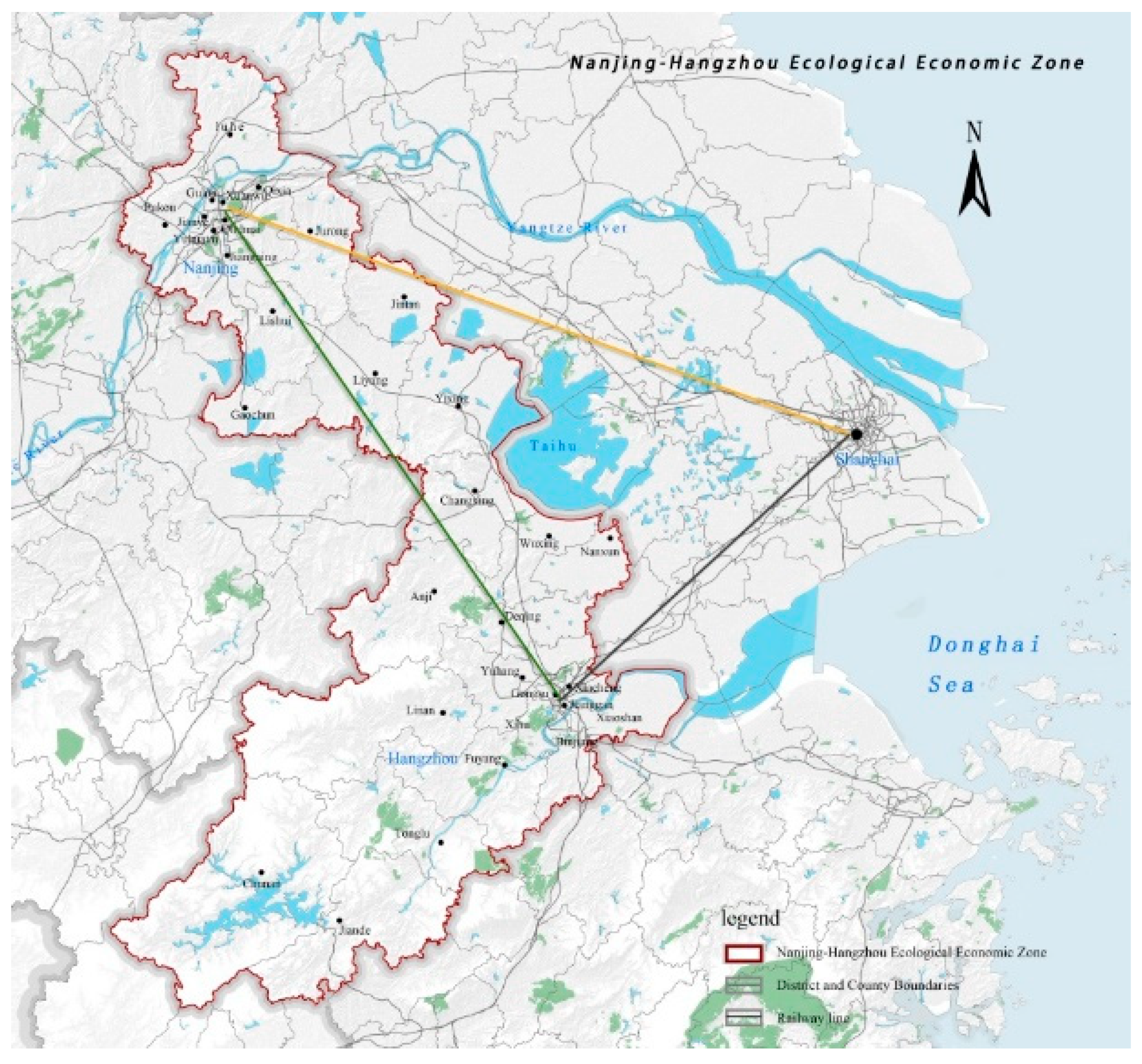
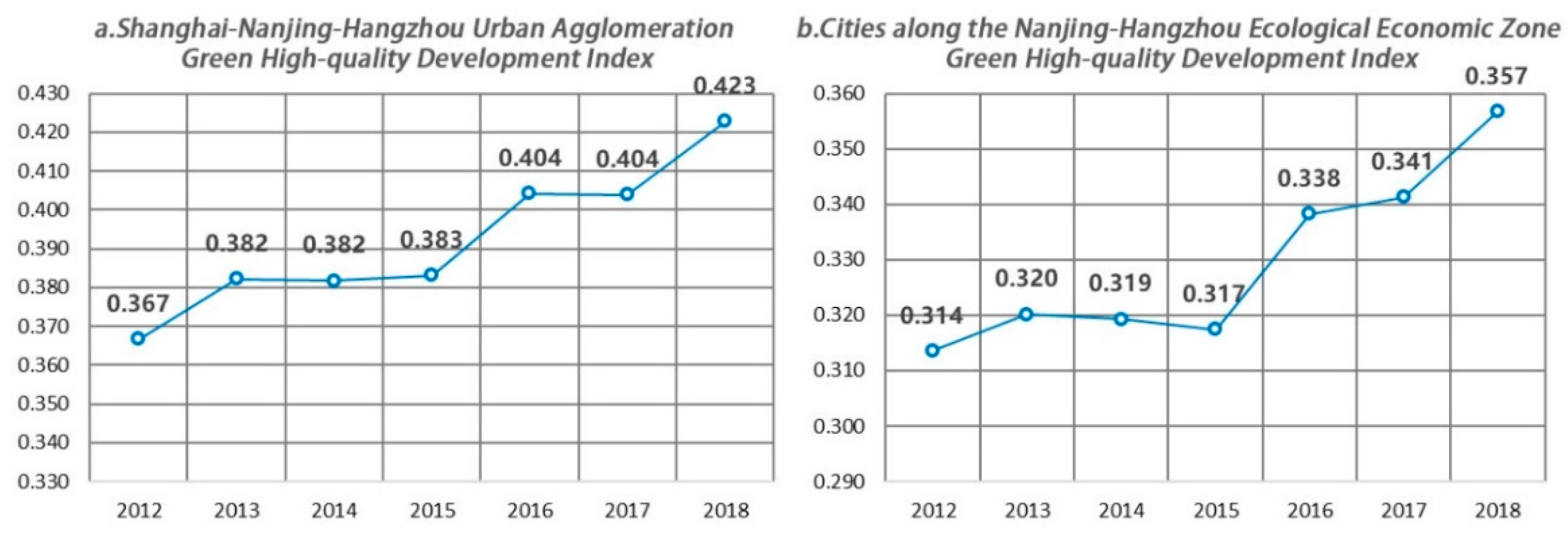


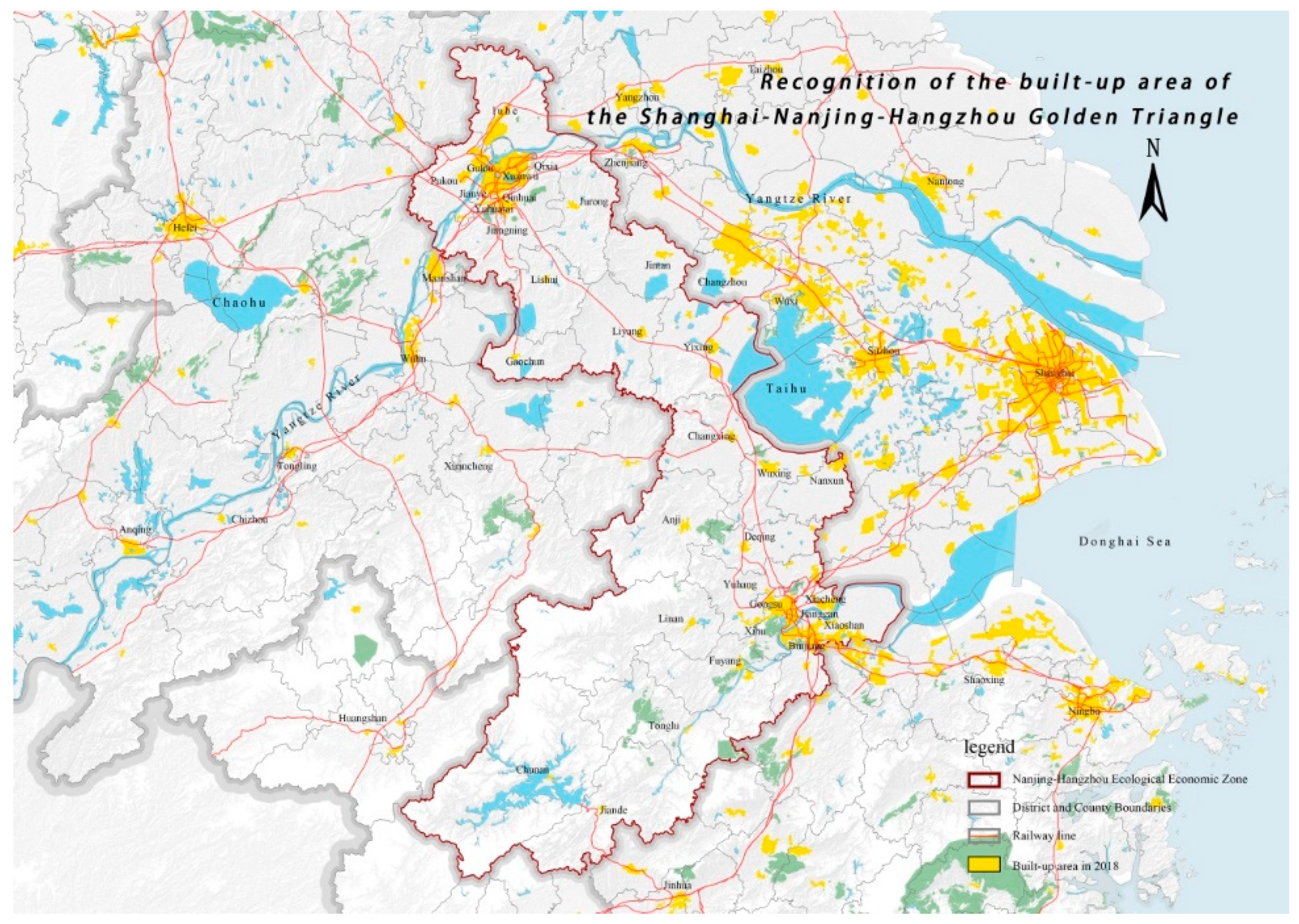
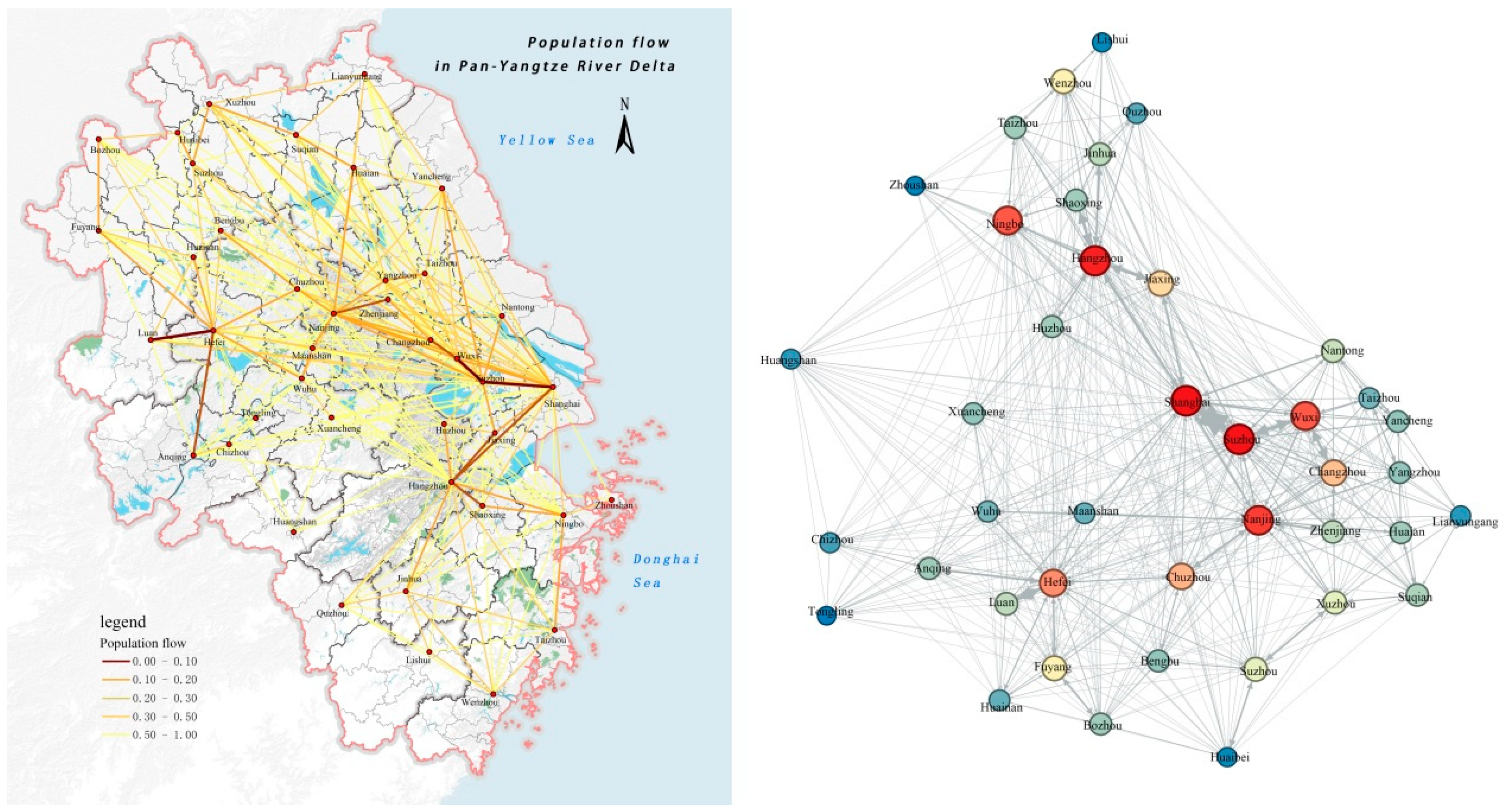
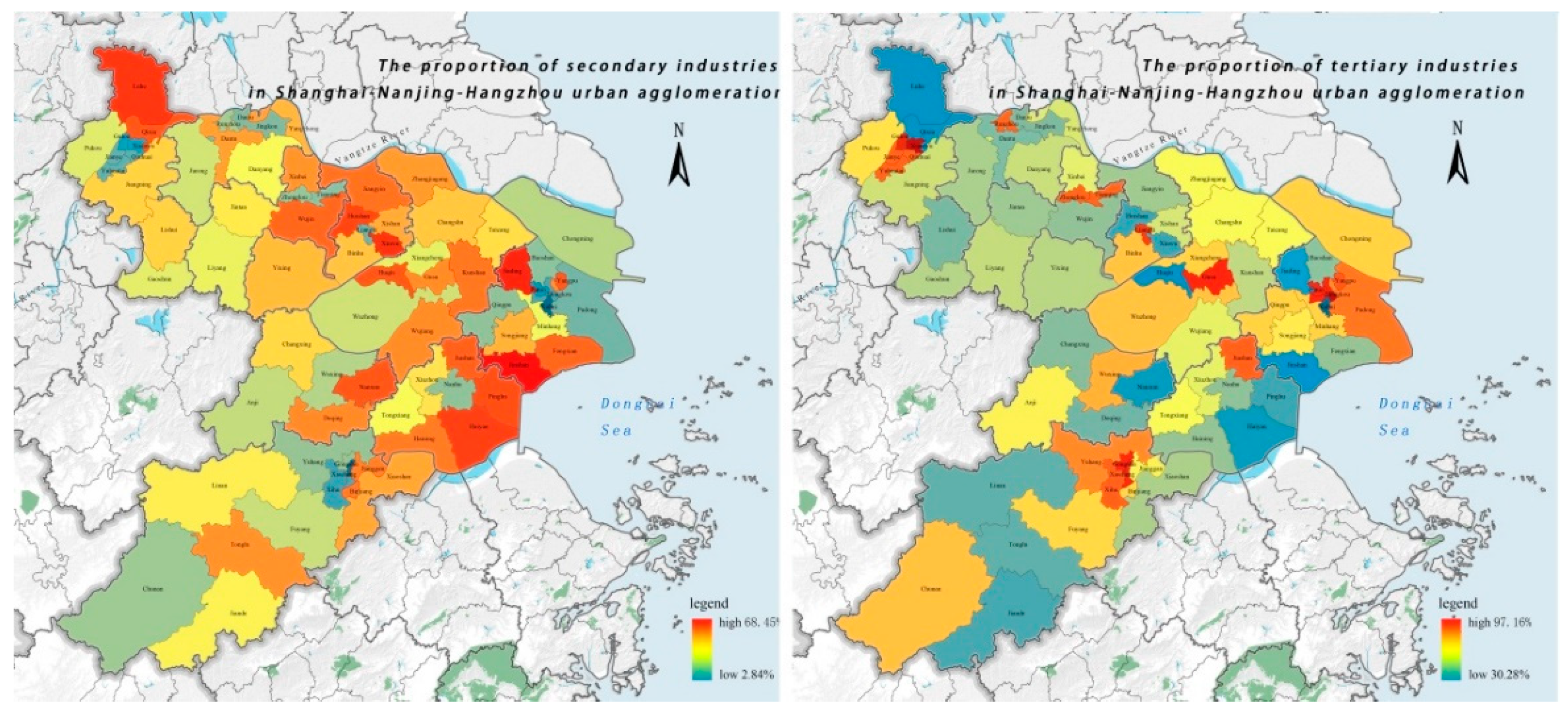
| Target Layer | Rule Layer | Specific Indicators and Codes | Unit | Index Attribute | |
|---|---|---|---|---|---|
| The Green Development Indicators | Economic Performance B1 | X1 | Per capita GDP | ten thousand yuan | Positive |
| X2 | Proportion of tertiary production | % | Positive | ||
| X3 | Public financial revenue | hundred million yuan | Positive | ||
| X4 | Public financial expenditure | hundred million yuan | Positive | ||
| X5 | Labor force employment | % | Positive | ||
| X6 | Industrial output value above designated size | hundred million yuan | Positive | ||
| Social Welfare B2 | X7 | Per capita disposable income of urban residents | yuan | Positive | |
| X8 | Per capita social consumption retail sales | yuan | Positive | ||
| X9 | Books in public libraries per 100 people | piece | Positive | ||
| X10 | Number of beds per 10,000 people | piece | Positive | ||
| X11 | Green area per capita | M2 | Positive | ||
| Innovation drives B3 | X12 | Proportion of technology expenditure | % | Positive | |
| X13 | Proportion of education expenditure | % | Positive | ||
| X14 | The number of college students per 10,000 people | people | Positive | ||
| Environmentalload B4 | X15 | Industrial waste water discharge per unit of GDP | t | Negative | |
| X16 | Sulfur dioxide emissions per unit of GDP | t | Negative | ||
| X17 | Industrial dust emissions per unit of GDP | t | Negative | ||
| Green governance B5 | X18 | Industrial dust removal volume | t | Positive | |
| X19 | Comprehensive utilization rate of industrial solid waste | % | Positive | ||
| X20 | Sewage treatment rate | % | Positive | ||
| X21 | Domestic waste treatment rate | % | Positive | ||
| Year\ City | 2012 | 2013 | 2014 | 2015 | 2016 | 2017 | 2018 | Mean | Range |
|---|---|---|---|---|---|---|---|---|---|
| Nanjing | 0.324 | 0.379 | 0.361 | 0.353 | 0.413 | 0.414 | 0.426 | 0.381 | 0.102 |
| Zhenjiang | 0.261 | 0.257 | 0.266 | 0.267 | 0.258 | 0.244 | 0.260 | 0.259 | 0.023 |
| Changzhou | 0.286 | 0.307 | 0.306 | 0.317 | 0.323 | 0.338 | 0.342 | 0.317 | 0.056 |
| Wuxi | 0.338 | 0.358 | 0.325 | 0.312 | 0.348 | 0.355 | 0.362 | 0.343 | 0.050 |
| Huzhou | 0.267 | 0.221 | 0.258 | 0.254 | 0.262 | 0.263 | 0.268 | 0.256 | 0.047 |
| Hangzhou | 0.421 | 0.422 | 0.418 | 0.414 | 0.449 | 0.458 | 0.512 | 0.442 | 0.098 |
| Suzhou | 0.368 | 0.427 | 0.453 | 0.453 | 0.482 | 0.445 | 0.476 | 0.443 | 0.114 |
| Shanghai | 0.737 | 0.771 | 0.748 | 0.773 | 0.788 | 0.801 | 0.832 | 0.779 | 0.095 |
| Jiaxing | 0.298 | 0.297 | 0.301 | 0.305 | 0.315 | 0.317 | 0.327 | 0.309 | 0.030 |
| Year | Economic Performance B1 | Social Welfare B2 | Innovation Drive B3 | Environmental Load B4 | Green Governance B5 |
|---|---|---|---|---|---|
| 2012 | 0.265 | 0.334 | 0.432 | 0.540 | 0.621 |
| 2013 | 0.268 | 0.368 | 0.451 | 0.581 | 0.639 |
| 2014 | 0.273 | 0.360 | 0.472 | 0.587 | 0.644 |
| 2015 | 0.274 | 0.353 | 0.512 | 0.588 | 0.660 |
| 2016 | 0.276 | 0.397 | 0.582 | 0.602 | 0.676 |
| 2017 | 0.279 | 0.410 | 0.594 | 0.623 | 0.684 |
| 2018 | 0.285 | 0.415 | 0.632 | 0.631 | 0.687 |
| City | Permanent Population in 2018 (10,000) | Increase or Decrease (10,000) | Registered Population in 2018 (10,000) | Net Population Inflow in 2018 (10,000) | Urban Population in 2017 (10,000) | Urbanization Rate in 2018 |
|---|---|---|---|---|---|---|
| Shanghai | 2423.78 | 5.45 | 1447.57 | 976.21 | 2418.33 | 87.60% |
| Nanjing | 843.62 | 10.12 | 696.94 | 146.68 | 642.68 | 82.50% |
| Hangzhou | 980.6 | 33.8 | 774.1 | 206.5 | 637.07 | 77.40% |
| Suzhou | 1072.17 | 3.81 | 703.55 | 368.62 | 332.94 | 76.05% |
| Wuxi | 657.45 | 2.15 | 497.21 | 160.24 | 254.77 | 76.28% |
| Changzhou | 472.9 | 1.13 | 382.2 | 90.7 | 188.57 | 72.50% |
| Zhenjiang | 319.64 | 1.01 | 270.78 | 48.86 | 89.17 | 71.20% |
| Jiaxing | 472.6 | 7 | 360.44 | 112.16 | 94.28 | 66.00% |
| Huzhou | 302.7 | 3.2 | 367.06 | 35.64 | 93.3 | 63.50% |
Publisher’s Note: MDPI stays neutral with regard to jurisdictional claims in published maps and institutional affiliations. |
© 2022 by the authors. Licensee MDPI, Basel, Switzerland. This article is an open access article distributed under the terms and conditions of the Creative Commons Attribution (CC BY) license (https://creativecommons.org/licenses/by/4.0/).
Share and Cite
Tao, D.; Zhou, W. An Evaluation and Optimization of Green Development Strategy for the Nanjing-Hangzhou Eco-Economic Zone in China. Sustainability 2022, 14, 17002. https://doi.org/10.3390/su142417002
Tao D, Zhou W. An Evaluation and Optimization of Green Development Strategy for the Nanjing-Hangzhou Eco-Economic Zone in China. Sustainability. 2022; 14(24):17002. https://doi.org/10.3390/su142417002
Chicago/Turabian StyleTao, Dekai, and Wenli Zhou. 2022. "An Evaluation and Optimization of Green Development Strategy for the Nanjing-Hangzhou Eco-Economic Zone in China" Sustainability 14, no. 24: 17002. https://doi.org/10.3390/su142417002
APA StyleTao, D., & Zhou, W. (2022). An Evaluation and Optimization of Green Development Strategy for the Nanjing-Hangzhou Eco-Economic Zone in China. Sustainability, 14(24), 17002. https://doi.org/10.3390/su142417002





